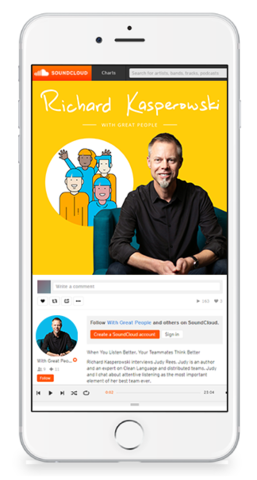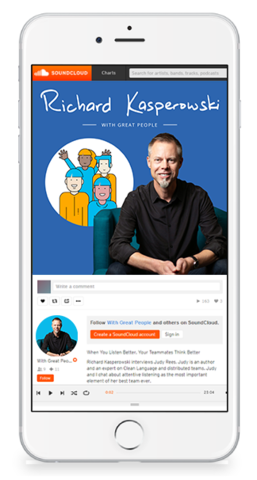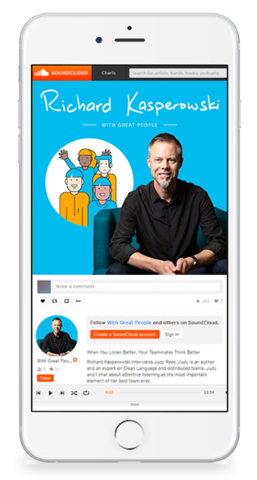Categories
Seb Rose: The Secret of a Good Team is a Shared Goal and What Else?
In this episode, Richard interviews Seb Rose. Seb is a Continuous Improvement Lead at SmartBear, a co-author of the BDD books Discovery and Formulation, and a regular guest lecturer on behavior-driven development in Richard’s course at Harvard. Seb tells us how to make a highly effective team even if the team members at your disposal are not as seasoned professionals as you would hope. When you finish listening to this episode, connect with Seb on Twitter (@sebrose) and read his books Discovery and Formulation.
Watch video
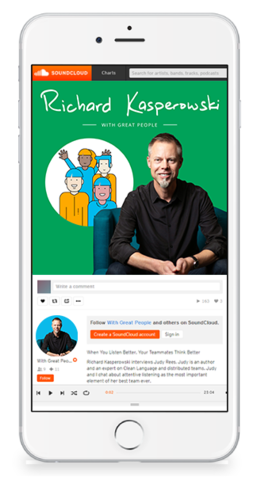
Listen Audio
Seb Rose: The Secret of a Good Team Is a Shared Goal and What Else?
with Seb Rose
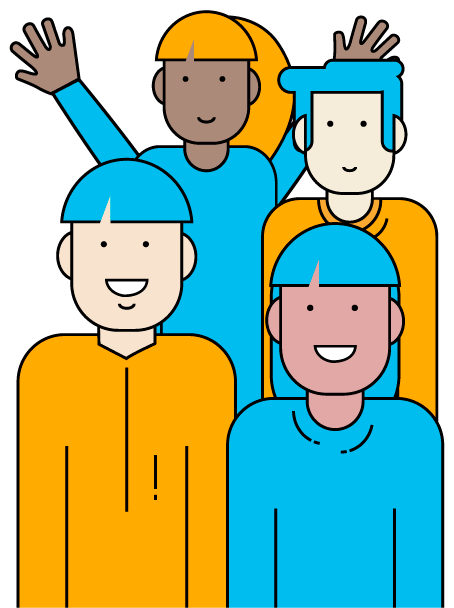
TRANSCRIPT
Richard:
Hi friends. Welcome back to, With Great People, the podcast for high performance teams. I’m Richard Kasperowski. Our special guest today is Seb Rose. Seb and I met on a train in Budapest. We just happened to be sitting next to each other. We struck up an amazing conversation and we immediately became friends. Seb is now a regular guest lecturer on behavior driven development in my course at Harvard. To support this podcast, this is my website kasperowski.com.
Richard:
Hey Se, thanks for joining today. It’s so great to have you here.
Seb:
Thanks, Richard. It’s been a long time since Budapest.
Richard:
It has and I miss it. It’s the craft conference and by the time this gets published, it will have then a few weeks ago but it’s online this year and I’ll miss the train rides.
Seb:
Indeed yeah. I was planning to go down there last year and it got canceled completely. So I guess we’ll just have to make do with virtual speaking over the wire from our little black boxes.
Richard:
That will work fine. And you’re literally in it and we’re both in black boxes. Mine just looks like it’s not black. So I introduced you as we met on a train. You’re a guest lecturer in my course at Harvard. Is there anything else you want to add on to that intro?
Seb:
Well, I think that covers all the main things. Apart from that, I’ve been working in the software industry for longer than maybe I should have done. I think I wrote my first commercial software in 1980. These days, I mainly work in behavior driven development. I’ve been part of the Cucumber team. I’ve written some books about BDD with my colleague, Gaspar Nagy and I worked for SmartBear as a continuous improvement lead. So I’m working with lots of teams at the moment. Across the world because SmartBear is one of these companies that grows through acquisition. So I have colleagues in India and Russia and France. And of course on the West Coast of the United States.
Richard:
Even as far away as the exotic West Coast of the United States.
Seb:
Absolutely. In fact one of my colleagues from Cucumber is now, well, I was going to say he’s on the West Coast of Canada but he’s in the Western states of Canada but apparently it’s still a day’s drive from the coast because yeah-
Richard:
Because it’s a big continent. Okay. You said you’re a continuous improvement coach?
Seb:
Well I’m called continuous improvement lead.
Richard:
Lead, what the heck is that?
Seb:
What the heck is that? So, because SmartBear grows through acquisition, there are lots of teams that all do things differently and are all different levels of maturity. And if I’m going to use the corporate buzzword, excellence, I was offered a position of being excellence lead. And I just thought that was just a… That just sucked as a title.
Richard:
Hello, your excellence.
Seb:
Yeah, exactly. Something like that. Where is my ermine cloak today? So instead, really what they’re talking about is just trying to get better at doing things because everyone can get better and we tend to get better in discrete jumps but equally that happens continuously. So you continuously practicing and then every now and then you look back and go, “Oh, wow. We, as a team or I as an individual have moved up another level before plateauing again.” So yeah, that’s what I’m doing working with teams across the SmartBear portfolio to try and ensure that the software that we deliver is of the quality that we would like to help our customers develop as well.
Richard:
All right. That’s so cool. So you’ve got a lot of experience with teams, which is perfect because this is the podcast about teams. And so, here we define team as any group of two or more people aligned with a common goal.
Seb:
Sounds good.
Richard:
And we ask everybody, we ask every guest, what’s the best one of those you’ve ever been a member of in your life, the best group of two or more people, the best team, what was the best team in your life?
Seb:
Yeah. So, I’m glad you gave me some warning about this, Richard, because if you hadn’t, I would have been struggling to think about which team to go for. But I’m going to go for a team that actually has nothing to do with software and a team that was formed in 1998. I own a piece of ground in Scotland that when I acquired it, it had nothing on it apart from some weeds and some trees. And I built a straw bale building on it. So you know those rectangles of straw that you get? Well, they actually make really good bricks. If you pile them together like Lego, they turn into really excellent walls. They have wonderful… Hey, I’m doing the wrong thing here. This is not about the team. Anyway, for anybody that’s listening to this who’s interested, look up straw bale building and particular, the style that I’m about to talk about it was Nebraska style.
Seb:
So we imported it from the US back into the UK. But I wanted to build a frame and the frame was being built out of Douglas fur, but Douglas fur in chunks that were like a foot by a foot for the main supports. And we building it from scratch. We got the sawn timber but you had to put all the joints into and notch it and do mortise and tenon joints. And I know nothing about woodwork. So of course that’s a bit of a challenge. And I rang up a lot of my friends and I actually got seven or eight of my friends to come out and join me for a week on this piece of land with this wood. And none of them knew anything about woodwork either but we had one awesome, amazing person called Pete, who came up from England, who was an expert from a company called Carpenter Oak, who happens to be the husband of a friend of mine.
Seb:
And he came up and he mentored us for a week. And the team was just the best team that I can ever remember because we worked so well together. We learned everything we needed to know about woodwork in that week. Pete managed to teach us everything we needed to know, not the theory, just the things we needed to know. And he did it in a way that didn’t treat us like dumb people. He helped us where we needed help. He let us make mistakes where we needed to make mistakes. He didn’t let us cut through a 12 inch piece of timber in the wrong place, right enough. But at the end of the week, we had this incredible structure up and it’s still up today.
Richard:
So I love a lot of what you said. At first it just sounds like it was a lot of fun. This group of friends coming together with a mentor and not theory that you didn’t need to know. So it was all practical stuff to get it done. And the mentor let you make mistakes. You didn’t say safe mistakes but anyway, I’m going to use that word, safe mistakes. And you use this counter example, he didn’t let you cut through a 12 foot long timber. That would’ve been a bad mistake.
Seb:
That would have been a bad mistake.
Richard:
And nobody lost any arms or fingers.
Seb:
No one lost any limbs. No injuries. There was actually, there was one mistake that was actually one that Pete made right at the beginning. So when he made the cutting list, he missed out specifying the timber for the queen posts, which is quite significant. And because it was, those were supposed to be, I think the eight by eight inch pieces of timber, not easy to get from our local lumberyards-
Richard:
Those are big.
Seb:
Yes, chunky, chunky things. So what we did was we basically went and got two and a half by two and a half pieces of timber, which is fine and nailed three of them together. And it’s… Yeah, they hidden behind the walls these days. So you can’t see them, but, but yeah.
Richard:
Is this the house that you’re in? Is this a different building that we’re talking about?
Seb:
Yeah, this is the first house that we lived in here. I’m, I’m a serial house builder. So I just wander around the place, putting in more houses whenever I get bored.
Richard:
Listeners and viewers be warned.
Seb:
They’re all on my piece of ground. Okay. I don’t go and do gorilla houses and other people’s pieces of ground.
Richard:
Be careful where you invite Seb.
Seb:
So in fact, one of the things that came out of that project, so the timber structure we put up in 98 and then in 99, that autumn or that fall, we had this conversation earlier. We took delivery of a whole bundle of straw bales, a lorry load, a truck load of straw bales. And then we built the walls in 99. And then I took that experience and I turned it into a four hour workshop software conference called Object Technology in 2003 in Oxford, which was quite fun.
Seb:
I wasn’t able to actually do the workshop with actual store bales. We had to use plasticine and drawings but nonetheless. There’s a lot of links between building things and software. And there’s a lot of things that seem similar and are actually very different. And there are some things which seem tenuously connected and are in fact, really similar. So we’re here talking about teams. Teams really are similar between a crew that’s working together on a building site and a crew whether localized or distributed that we’re working together on a software project. The different thing is that software, you build it once and you can crank it out as much as you like. Whereas with buildings, you design them once but you build them over and over again. So there’s quite a different approach to scaling between physical building and software building.
Richard:
Right. Okay. So, this amazing team, it was you, five friends and the mentor Pete, right?
Seb:
Yep.
Richard:
As you take yourself back to that team, I see the smile on your face. Viewers can see the smile on your face. So it’s obviously a good experience. What did it feel like? What does it feel like as you take yourself back, what’s the sensation that’s arising in your body and could you put a word on that sensation?
Seb:
Yeah, I guess I’m nostalgic. Probably. So for me it was a high point of my life so far. I mean, I’ve worked with some great teams since then. But Hey, this is a team we actually lived together for a week. So in a caravan and in tents, we ate together every evening. There were a lot of empty bottles to be got rid of at the end of the week. And yet we still, every day we got up, not quite when the sun came up, but we got up and we worked on this timber and this thing just took shape around us. So we were having fun. And yet we were amazingly productive in a way that I rarely get to experience or have rarely experienced in commercial software organizations.
Richard:
To have an experience like that building software, that would be so cool too.
Seb:
Wouldn’t it? So, I mean, people talk about Coderetreat, as an experience that is similar in the sense that it’s not tarnished by the exchange of small green bills, you do it for fun. You do it with groups of people, you get a chance to practice safely. There’s somebody there to give you hints or offer suggestions as you go. There’s a lot of similarities. At the end of a Coderetreat you probably don’t take the software with you. As You were working on something that was Kata. Like, whereas we ended up with a building that people still live in. Which is it’s really quite an excellent side effect of having a good time.
Richard:
No imagining the possibility of the Coderetreat, where you build something that lives on. Something that’s durable.
Seb:
So that has been done, hasn’t it? So there have been hackathons themed around various things where something comes out of them.
Richard:
Yeah. This amazing structure building. Hes building team. What are some of the subjective ways that you know this was a great team?
Seb:
We’re still friends, right? So, that is something that I’ve seen from other teams that I’ve worked in, in the software industry, they may not have been quite as much fun. They may not be in 24/7 type situations but the good teams I worked on. I still keep in touch with people that were on those teams. We meet or at least we used to meet regularly. These days, we communicate by other means. So subjectively the fact that we’re all still good friends, that’s… And in fact, one guy who couldn’t make it through the week because he had a job at the time and he just came over the weekend. He still remembers the day, one day that he spent with us. And he says, that was the best day he’s ever had. So, subjectively we have a number of common touch points and we talk about it on a semi-regular basis.
Richard:
All right. Now, anything else subjectively or objectively that you sense within yourself or that people could observe from the outside?
Seb:
Well, I think everyone who ever looks at this building, melts a little because it just looks, I mean, it’s both structurally signed and yet idiosyncratic to the point of absurdity. So the thing about straw bales is that they look quite flat sided until you actually smear plaster on them. And then you discover quite quickly that they have different widths and they have undulations and things. So it looks a bit like a Hobbit house. It now has grass and stuff growing out of the roof. It’s got a little chimney that puffs smoke and it’s got both of the gables are fully glazed. So it’s got a great look and feel to it. And the people that live in it now have put in flowers all around it. So it just looks like a yellow gingerbread building sprouting out of a field of flower heads. Yeah. It’s quite an interesting view. And subjectively, you wander down and they go, “Ah, that was really…” It wasn’t just fun doing it. It actually is functional and it looks nice as well.
Richard:
That is so cool. That is so cool. So what were some of the concrete behaviors that you engaged in together as teammates building this house?
Seb:
So communication. We were always talking about who’s doing what. We were having to lift large blocks of wood. You don’t do that on your own. Some of these were 15 foot long, so you had three or four people on them. We built our own tools. So for instance, when you’re working on large pieces of wood, you don’t want to have to be bent over with them laying on the ground. So the first job that we did was we built the trestles. And so Pete came with a blueprint of a trestle, which some architect or designer had specified, designed and said, “These can hold a ton.” So he’d come with a blueprint of a tool. The first job we did was we built the tools and then for the rest of the week we’d been using, and in fact, I still use those trestles.
Seb:
The Trestles are outside now with lumber on them because they were just such good tools. So we worked together. Pete brought a lot of tools himself, the actual metal tools. And then there was the experience of being led through something that would have been quite frightening if you didn’t have an expert there. And yet was really quite simple. Once you have been shown how to do it. So for instance, I don’t know if anyone listening has ever done any significant joinery or house building but there’s a former joint called the mortise and tenon. And this is a fancy word for saying, it’s a socket in a piece of wood. And a piece of another timber is cut down to size to fit into that socket. And then you hold it together by knocking a peg through a hole that you’ve drilled in the side. And all of that-
Richard:
I’m scared.
Seb:
It’s kind of, because if you screw it up, that’s a whole piece of word wasted but actually when you got an expert there. He goes, “No, you want to do it a bit straighter than that. No, you want to not go around the corners or yeah and what you do is you push the tenon into the mortise and then you pull it back a quarter of an inch and then you drill the hole. And now when you knock the peg in, it pulls the mortise tight against the other piece of word and clamps it.” It was… So what are we trying to talk about? I’m trying to say these were the activities of us working together with a mentor who is showing some really quite complex construction techniques but doing it in a way that everyone walked away with the knowledge of how to do that. And there was no wasted material. There was no fingers bleeding or broken bones. It was great.
Richard:
That’s amazing. Okay. So how about listeners and viewers, what can they take away from this? What advice do you have for them to have the best team of their life on purpose?
Seb:
Well, so the best team I reckon is a bunch of people who are working towards a common purpose because they want to. They have to be engaged in the activity. And that’s hard to do in the commercial organization because we probably all know the experience. You first and foremost, you need to put food on the table and pay the rent. And so you’re often there for a reason that’s extraneous to the actual work that you’re supposed to focus on. Having said that there are a lot of people in this industry that are very bought into what they’re trying to do. And they pick companies that have goals and values that are aligned with them. So if you can work with a team of people who have a common goal, a common purpose and aligned values, I think you’re already on the way to having one of the best experiences of your life.
Seb:
Additionally, a lot of organizations, especially organizations that look for aligned values have or used to have, annual get togethers. Their off-sites where they might do some work related stuff during part of the offsite. But for other bits, you would do team building and group activities. That’s what this was. This was essentially a one week group activity. And then we never ever worked together again because we came together for a particular purpose. So if you can get activities where you can build a team where you can do something fun, you can bring in the whole team and possibly their families, you can eat together, drink together, laugh and shite together and still get up and do something productive in the morning that builds a team, the feeling of a team, like nothing else I’ve ever experienced.
Richard:
It’s beautiful. And I want that. I love the way you added on. I like to say team as a group of two or more people aligned with a common goal and you add on because they want to and they have their values aligned. Yeah. That’s just perfect.
Seb:
I think that’s really quite important. And there’s an awful lot of, so I’ve done a lot of coaching and training over the years and I’ve worked with executives and team managers and CEOs and the like and there’s a lot of talk about team building. And quite often it’s a tick box exercise. Let’s have an offsite, team build done and it’s just not right. If you have people that have very different perspectives, very different worldviews, there is going to be friction and it’s going to be hard to get them to really collaborate effectively.
Richard:
So, how about that being aligned, having values that are aligned, how do you discover that? Or how do you do that?
Seb:
Well, that’s a really difficult question and not one that I think I have an answer to. I mean, I discovered that when I was building the timber structure because these were friends that I had acquired over the previous decade and over a very seminal part of my life from when I went through university and college and my first job. So there was a bond there. When it comes to organizations, I would say the closest I got to that was when I was part of the founders or second round of founders of the Cucumber Limited organization. So there we were all very much pulling in the same direction. We were aligned that the challenges of software development were predominantly social and based in communication rather than necessarily technical, it’s not that technical challenges don’t exist, it’s just that they’re second order problems.
Seb:
We can generally, unless you’re working right on the bleeding edge, the technical challenges are generally not the things that cause software companies to fail. It’s not having the vision, not understanding what other people are saying to you in the way that they intended you to understand that. And so Cucumber because it’s built on behavior driven development because it’s built to support the discovery and formulation and collaboration that leads to business readable specifications because it’s absolutely tied into trying to make sure that everybody has a shared understanding, Cucumber was that organization. It was as close to the aligned group of energized people with the same values as anything I’ve had in the IT world.
Richard:
Cool. And for people who aren’t in IT or don’t know, Cucumber was the name of the company, is the name of the company.
Seb:
So Cucumber was initially an open source product that was created by Aslak Hellesoy, and then to support development of a commercial product that was going to be called Cucumber Pro and then was to be called Cucumber Jam. They founded a company called Cucumber Limited and there were the three founders initially and then another two. And then it got bought by SmartBear, which is who we now all work for. SmartBear continue to support the Cucumber open source tool and are producing a commercial product called Cucumber Studio.
Richard:
Got it. Sort of like a Spinal Tap story of how we got our name and how we…
Seb:
Well, the story and people regularly ask this, so I might as well just put it out there, is, how come it was ever called Cucumber in the first place? And the story goes that Aslak was actually living in Chicago at the time with his wife, Patty. And he’d been working for ThoughtWorks. And he’d worked with Daniel Terhorst-North, who created invented behavior driven development. And so Asllak created this tool Cucumber, which was a bit like our spec but different. And he turned to Patty and said, “What shall I call it?” And she just said, “Well, why not call it Cucumber?” And Aslak’s response was, “Well, that’ll do for now.”
Richard:
The Cucumber method of product naming.
Seb:
Exactly. So I don’t know, are you familiar with Arlo Belshee’s article on the seven stages of naming?
Richard:
That’s who I was summoning right there. He taught me the poop method of variable learning. Because you don’t really want it to be called poop, but don’t stop and think about the correct name right now. You’ll notice that word poop in there and your code and you’ll fix it for sure.
Seb:
So, I love that article and I fully buy into Arlo’s philosophy there. However, I once worked for a company called QSS, Quality Systems and Software and I did some work there. I ported a C code based to C++. I stayed for a year, a year and a half and then moved on. A decade later, they’d been acquired by a Swedish company called Telelogic and I was back working for them. And I was working on the same code base. And I discovered a comment that I had written in the code base. And it said remove this after the next release. A decade later it was still there.
Richard:
Definitely get rid of this line of code.
Seb:
Delete me.
Richard:
All right. What else do you want to add? What else can you tell us about yourself? What else about teams? What else about anything that’s happening?
Seb:
Okay. Well, I think I’ve talked a lot about not software stuff. After we finished this podcast, I’m going to be going out into the garden and I have got brassica’s to plant, so that’s cabbages.
Richard:
Cabbages.
Seb:
Okay. So I’ll be [crosstalk 00:26:47]
Richard:
For us. Vocabulary, stunted Americans.
Seb:
Exactly. I’m sure you call them brassica’s in the horticultural industries in America as well. Well, there’s a few things that I would like to punt, if you like. So the first thing is that, as I mentioned briefly earlier on Gaspar Nagy and myself have written the first two books in the BDD book series, they’re called Discovery and Formulation. Discovery, we released maybe three or four years ago but Formulation, we only released in 2021. So it’s quite fresh off the press. And no, I won’t tell you about special offer because by the time this podcast goes out, this special offer will be finished. But anyway, the books are short. They’ve got wonderful five-star reviews. And if you’re into behavior driven development, then I think you would benefit from them in the same-
Richard:
Very, very briefly. What is behavior driven development?
Seb:
Oh right. Behavior driven development is an approach to developing, an agile approach to developing software, which is based on collaborative shared understanding. So this Cucumber tool that I was talking about earlier was created to support behavior driven development. So in behavior driven development, we collaborate and when I say we were talking about developers, testers and business people, product owners and customers collaborate to get to a shared understanding of one story. So in this incremental and iterative way, we don’t do the whole product. We just think of the next thing we want to work on. Once we’ve got to that shared understanding, we then formulate the examples that we use to get to that understanding in business language. So it becomes documentation. And then finally we automate that business language documentation using a tool like Cucumber, which means that that documentation will be provably and demonstrably correct for all time, all the tests will fail. So it’s a really wonderful way of both working together and having the best of machine quality assurance.
Richard:
All right. Thank you.
Seb:
And if you want to know more about it and you don’t want to pay any money on somebody’s daft books, SmartBear have released free video classes at school.cucumber.io where you will be able to go through, depending on how far you want to go. There’s a course that just does one lesson. And then if you’re actually into the programming, there’s a course that takes you through 10, 11 lessons of developing for different flavors of Cucumber. So those are the two things that I wanted to let people know about the books, the BDD book series, available from bddbooks.com and the free videos at school.cucumber.io.
Richard:
Perfect. Thanks for sharing that. And if listeners or viewers want to get in touch with you, how could they do that?
Seb:
Well, there are a number of different ways. So I hang out on Twitter and my Twitter handle is @sebrose. I work for SmartBear. So my email address is seb.rose@smartbear.com and if you want to come and work in the garden or building straw bale buildings, you will find that you’re able to volunteer at a website called wwoof.org.uk that’s W-W-O-O-F.org.uk and I am listed under Acme Organics.
Richard:
That is so cool. My son did some WWOOFing sometime back.
Seb:
Excellent.
Richard:
And it was an amazing life experience. Yeah. Oh, so definitely if you want to go hang out with Seb, WWOOF with him, we use WWOOF as a verb, I don’t know if you do that.
Seb:
I think it is a verb, yeah.
Richard:
Well Seb, thank you. Thank you so much for joining us today. This was a great pleasure. I have a metric for how good a conversation was. I can feel the muscles in my face and in my belly from all the smiling and laughing. Thank you so much for this.
Seb:
Thank you very much for inviting me, Richard. It was fun. I haven’t had a chance to think or talk about that excellent team for quite a few months now. And it was really good.
Richard:
Wonderful. And listeners and viewers, remember to support this podcast, visit my website. Kasperowski.com.



